After leaving Cape Lookout, North Carolina, we ran for three nights to Massachusetts and stopped overnight at Plymouth so that we could enter Boston Harbor the following morning. As with Cape Lookout, we chose Plymouth mainly because it was a convenient and easy place to anchor without taking us too far off our route. But also like Cape Lookout, this was an excellent stop in the city where the Pilgrims settled in the New World in 1620.
Highlights from June 16th follow. Click any image for a larger view, or click the position to view the location on a map. And a live map of our current route and most recent log entries always is available at http://mvdirona.com/maps
 |
Warren Cove
Position: -70 37.02, 41 56.80
At anchor in Warren Cove off Plymouth Bay with Plymouth Beach stretching out to our west.
|
 |
Duxbury Pier
Position: -70 39.04, 41 58.91
The Duxbury Pier lighthouse, built in 1871, stands 47 feet high and has three levels used as living quarters and a watchroom. One hundred tons of stone were placed around the base to protect the light. This seems to have been effective, as the light survived a battering from 30ft waves during a 1944 hurricane. The lighthouse was automated in 1964 and no longer has resident keepers.
|
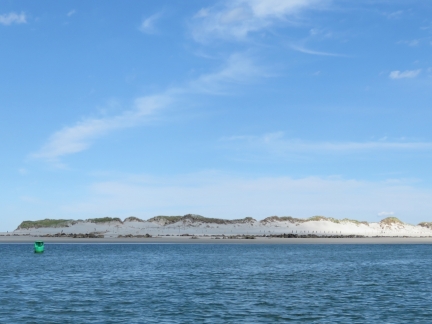 |
Sand dunes
Position: -70 39.38, 41 58.75
High sand dunes as we round beach point. Sand dunes really didn’t fit with our image of what to expect in Massachusetts.
|
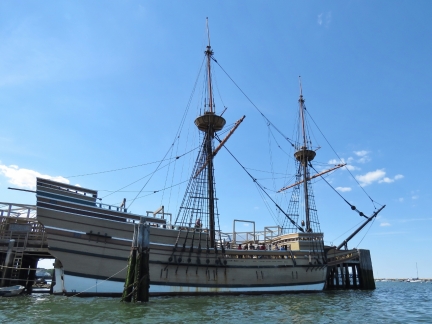 |
Mayflower II
Position: -70 39.71, 41 57.58
The Mayflower II, a working replica of the Mayflower that carried the first group of English Separatists, now known as Pilgrims, from Plymouth, England to the New World. The Mayflower II web site indicated that the ship was in dry dock for restoration, so we were excited to see it here.
|
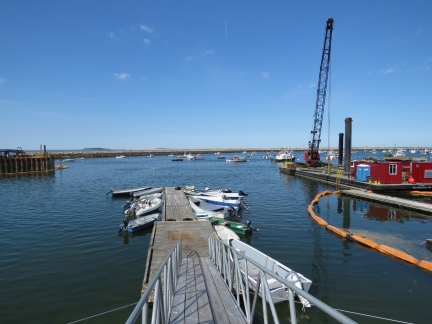 |
Public dock
Position: -70 40.01, 41 57.75
Our tender tied off at the public dock in Plymouth.
|
 |
Mayflower II tour
Position: -70 39.73, 41 57.60
It was late in the day, so we went straight to the Mayflower II in hopes of a tour. This is an actor playing Captain Jones, one of several actors on board playing characters from the voyage. He was extremely knowledgeable about the ship and did an excellent job of explaining the workings of the ship, the voyage to the New World and its dangers.
|
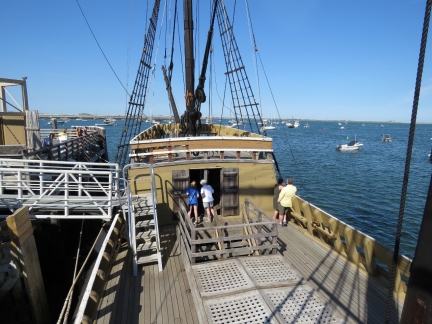 |
Deck
Position: -70 39.73, 41 57.60
The Mayflower was only 80-90 feet long on deck and 90-100 feet long overall. Below this main deck the 102 Pilgrims lived in incredibly cramped conditions for ten weeks during a stormy Atlantic crossing. They first anchored in what today is Provincetown Harbor, but decided to settle in what is now Plymouth. Only two died on the voyage across the Atlantic, but nearly half didn’t make it through the first winter.
|
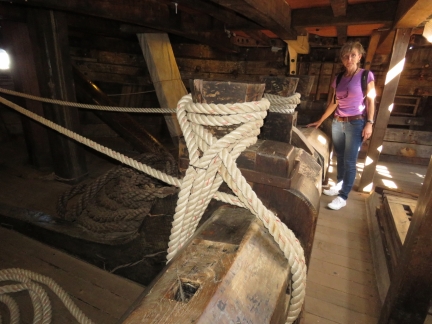 |
Windlass
Position: -70 39.71, 41 57.59
Now that’s a windlass.
|
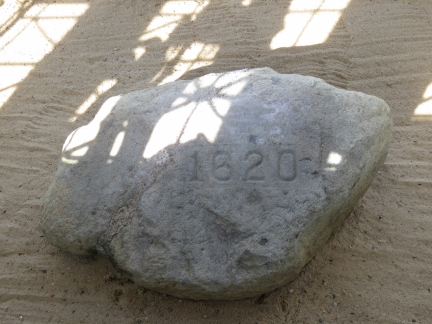 |
Plymouth Rock
Position: -70 39.73, 41 57.50
Plymouth Rock is said to be the first landing point for the Pilgrims in Plymouth. Their actual first landing point in the New World was at Providence at the tip of Cape Cod.
|
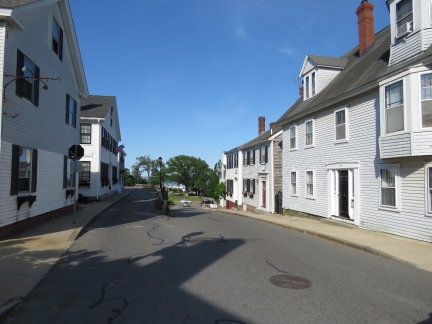 |
Historic
Position: -70 39.79, 41 57.38
Plymouth is a stately city, full of historic buildings.
|
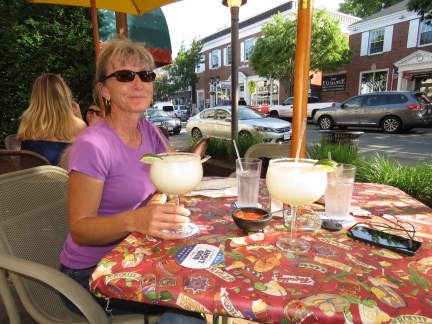 |
Sam Diego’s
Position: -70 39.88, 41 57.41
The patio at Sam Diego’s Mexican restaurant caught our attention as we passed. We had a great meal streetside on tree-lined Main St.
|
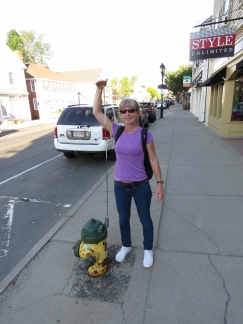 |
Snow markers
Position: -70 40.08, 41 57.52
If you’ve never lived anywhere where you’ve had to shovel snow over your head, you might wonder what these poles protruding from the fire hydrants are for. They mark a hydrant’s location under several feet of snow so the snow plow drivers don’t hit them and the fire department can find them.
|
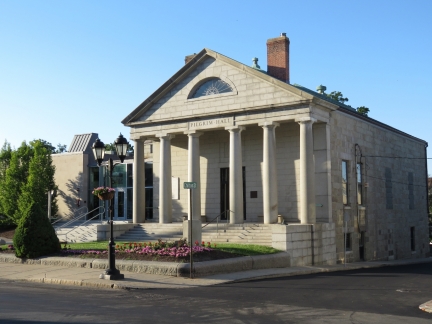 |
Pilgrim Hall
Position: -70 40.08, 41 57.52
The Pilgrim Hall Museum tells the story of the Pilgrims and the founding of America. Unfortunately the museum was closed for the day.
|
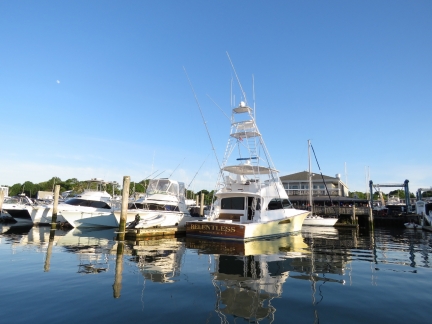 |
Brewers Marina
Position: -70 39.62, 41 57.40
Plymouth has a small marina that looked like it had space for us, but we’re happier at anchor.
|
 |
Sunset
Position: -70 36.99, 41 56.81
A fabulous sunset for our first night in Massachusetts.
|

|
Click the travel log icon on the left to see these locations on a map, with the complete log of our cruise.
On the map page, clicking on a camera or text icon will display a picture and/or log entry for that location, and clicking on the smaller icons along the route will display latitude, longitude and other navigation data for that location. And a live map of our current route and most recent log entries always is available at http://mvdirona.com/maps. |
If your comment doesn't show up right away, send us email and we'll dredge it out of the spam filter.

Hi, still loving the blog. When at anchor, how often do you deploy your flopperstopper? I only ask because with my N47 in the Med, I virtually always have to deploy it. Even flat calm bays seem to have enough of a wave action (sometimes only a couple of inches) to set us off rolling badly. Maybe with your extended waterline length you have a flat bottom extension? Does your prop and rudder sit in the same place as mine, or is it also 5ft further back? Thanks, Colin
Hi Colin. We deploy our Flopper Stopper on average 2 or 3 times a year. When we need it, we really do need it and are glad we have it but we realy don’t deploy it often. My theory is Dirona is a big heavy boat at nearly 110,000 lbs and so it tends not to roll too much in most conditions. Couple that with the extra weight of the flybridge, stack, etc. and the roll is a nice and lazy one rather than a snap roll. As a consequence we rarely deploy the flopper stopper. Our boat does have 5′ more waterline than your 47′ but I don’t think that would make much difference in the boats roll characteristics.
A real surprise is we didn’t bother to deploy it even in the open ocean moorage field at Saint Helena. I think the last deployment was in the Kimberley Region of Australia a bit more than a year back.
Thanks James, Have a look at Ken Williams’ Facebook entry with Mighty Mouse, N72 rolling in Majorca. We shared the bay with MM and Ken’s 68 and the worst roll was the 72, although we weren’t far behind with a damaged spine to the F/S so it wouldn’t close when rolling down! Sorry, can’t do the link thingy, but worth a look! Best wishes, Colin
From what Ken says about the Med, it may be we just haven’t seen many high roll anchorages thus far. The few we have found, the flopper stopper has dealt with well and surprisingly frequently, we just don’t need any additional stabilization at rest.
Duxbury Pier (Bug) Light was built in 1871 on the north side of the main channel in Plymouth Harbor. It is the first ‘spark plug’ lighthouse.
Thanks for catching that Paul. We’ve updated the date.
Love your blog! Extremely informative, not just the cruising info but all the technical stuff too.
My dream Nordhavn has a controlled pitch prop. In the course of your extensive travels have you ever formed an opinion as to whether a cpp would have been beneficial addition to your vessel’s spec?
Controllable pitch propellers are more efficient at most boat speeds and are ideally suited for boats that don’t always travel at the same speed. And they are especially good for lower than usual travel speeds when crossing oceans. Fixed pitch props are set up for a single fixed speed and might even be slightly better than a controllable pitch prop at that speed. But at all other speeds, they fixed pitch prop isn’t ideal. CPPs are mostly upside. The dimensions where they are weak are: 1) fairly expensive with $70,000 to $80,000 for the parts alone on a boat of the size of Dirona, 2) some additional complexity and failure modes, 3) a fixed pitch prop when damaged is cheap to fix whereas a CPP can be very expensive, and 4) some additional operator skill is required. It is possible to over-pitch accidentally and overload the engine. CPP requires a bit more operator skill.
Is the additional complexity and cost worth the efficiency gain? $100,000 is a lot of fuel so, unless the boat is used frequently and for a long time, I suspect it may not be an economic win. There is some value from slightly extended ranges and some additional costs is justified for that gain alone. Alternative ways to extending range like deck bladders are less expensive but they have their downsides as well.
The only Nordhavn that currently comes equipped with a controllable pitch prop is the 56 motor sailor.